Xalapa, Veracruz 作者: 来源: 发布时间:2021-11-15
1.Population and Area
Pop: 525,147 (city)
Area: 118.45 km2 (munip.)
Elev: 1417 masl
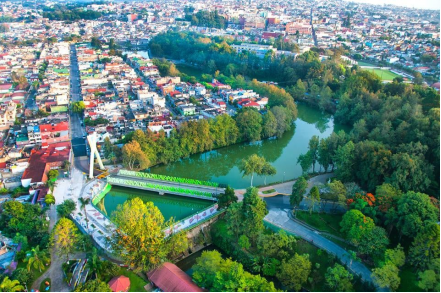
Xalapa location in Mexico within the state of Veracruz
https://goo.gl/maps/A9qitHqS3CrxEBNE9
2. Natural geography
Nature and weather
Physiography
The city is located on the eastern foothills of the Cofre de Perote (4282 meters above sea level) so its soil is irregular, without notable accidents, its main height being the Cerro de Macuiltépetl which rises to 1587 meters above sea level.
Hydrography
Streams and springs: Chiltoyac, Ánimas, Xallitic, Techacapan and Tlalmecapan.
Rivers: Sedeño, Carneros, Sordo, Santiago, Zapotillo, Castillo and Coapexpan.
Various artificial lakes and some natural ones.
Flora and fauna
According to the type of climate it presents and the surrounding topography, Xalapa is characterized by having the mesophilic mountain forest among its vegetation, in which we can find trees with a height that ranges from 15 to 35 meters high; It is generally a dense forest, the trunks of the trees can reach 2 meters in diameter and can be both evergreen and deciduous (losing their leaves in the cold months of the year), in such a way that the forest is never lacking in green. This type of forest develops at an altitude around 500 and up to 2,000 meters above sea level, and maintains an average annual temperature that can vary between 12 and 23 ° C. Due to these characteristics, this forest is often found in fragments with very specific microclimatic conditions. Among the most representative species of its vegetation is the Liquidambar (Liquidambar styraciflua). Predominant vegetative genera: Inga, Quercus, Juglans, Ficus, Fagus, Cornus, Clethra, Carpinus and Ulmus; Fruit trees: Peach, Lemon, Orange, Eggplant, Guava, Banana, Loquat, Cherimoya; Food species: Corn, Vegetables, Beans, Pumpkin, Chayote; Ornamental Plants: Roses, Camellias, Orange Blossoms, Gardenias, Tulips, Medicinal Plants: Chamomile, Rue, Higuerilla, Sauco, Mullein, Yerbabuena and the famous Xalapa Root. It is important to mention that much of the primary vegetation of Xalapa has been modified and has been transformed into agroforestry systems such as coffee, which is mainly intermixed with holm oak areas.
There is a great variety of wild animal species in the mountains surrounding the population, some are: skunk, coyote, opossum, rabbit, wild cat, squirrel, gopher (mole), armadillo, porcupine, badger and raccoon. It also has some varieties of snakes or snakes, as well as lizards and frogs. With regard to birds, you can see swallows, chachalacas, woodpeckers, parrots, owls, thrushes, eagles and hawks, it also has other or more species of animals, both birds and birds, and terrestrial animals and some aquatic animals.
Köppen Classification: Tropical Savanna Climate
This climate is characterized by relatively high temperatures and evenly distributed precipitation throughout the year. This climate type is found on the eastern sides of the continents between 20° and 35° N and S latitude. In summer, these regions are largely under the influence of moist, maritime airflow from the western side of the subtropical anticyclonic cells over low-latitude ocean waters. Temperatures are high and can lead to warm, oppressive nights. Summers are usually somewhat wetter than winters, with much of the rainfall coming from convectional thunderstorm activity; tropical cyclones also enhance warm-season rainfall in some regions. The coldest month is usually quite mild, although frosts are not uncommon, and winter precipitation is derived primarily from frontal cyclones along the polar front.
The Köppen Climate Classification subtype for this climate is "Cfa". (Humid Subtropical Climate).
The average temperature for the year in Xalapa is 66.6°F (19.2°C). The warmest month, on average, is May with an average temperature of 71.4°F (21.9°C). The coolest month on average is January, with an average temperature of 60.4°F (15.8°C).
The highest recorded temperature in Xalapa is 101.1°F (38.4°C), which was recorded in May. The lowest recorded temperature in Xalapa is 28.0°F (-2.2°C), which was recorded in November.
The average amount of precipitation for the year in Xalapa is 56.5" (1435.1 mm). The month with the most precipitation on average is June with 11.3" (287 mm) of precipitation. The month with the least precipitation on average is January with an average of 1.6" (40.6 mm). In terms of liquid precipitation, there are an average of 172.8 days of rain, with the most rain occurring in June with 19.6 days of rain, and the least rain occurring in April with 9.4 days of rain.
https://www.weatherbase.com/weather/weather-summary.php3?s=930228&cityname=Xalapa+-+Parque+Natura%2C+Veracruz%2C+Mexico&units=
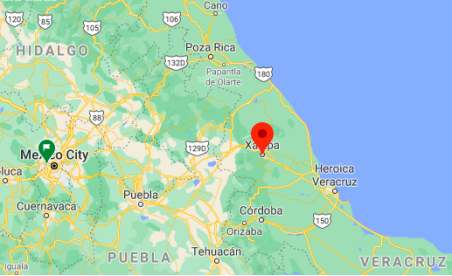
Getting there and around
Get there
By air – The Lencero Airport is a very small airport. It is situated outside the city but it is used only for helicopters and very small planes. The closest airport is the Veracruz international airport. It's about 2 hours from Xalapa.
By car – The distance between Mexico City and Xalapa is 232 km. The road distance is 293.7 km. It takes approximately 3h 29m to drive from Mexico City to Xalapa and costs $500 - $800, including tollbooths.
By bus – Almost-hourly buses go from Mexico City to Xalapa in several bus lines (ADO, AU), departing from TAPO station. The trip takes 4 hours approximately.
The direct bus departing from Mexico City TAPO and arriving at Xalapa. Services depart every 30 minutes and operate every day. The journey takes approximately 4h 40m.
https://wikitravel.org/en/Xalapa
https://www.rome2rio.com/s/Mexico-City/Xalapa
Car Rental – To explore Mexico’s provincial towns and cities—including its beach locations and the scenery and attractions near them— consider renting a car for your visit. Having your own car will give you more flexibility than using public transport options and, in some cases, offer you access to places which are otherwise difficult to visit without the use of a car.
COVID19 – International entry into Mexico from United States
Allowed for: All visitors arriving by air. Mexico land borders are closed to non-essential travel
Restricted for: There are no current restrictions.
Get around
Local Buses – Local buses and mini-buses (combis or micros) are available locally for a fraction of the cost of a taxi around town. You need to speak Spanish to be able to ask for directions or ask the driver to tell you where to get off.
Taxis – Taxis in most of Mexico’s towns and cities are not metered, so agree your price before you get in. Taxi travel is very affordable in Mexico, in comparison to the USA, Canada and Europe, and so provides a viable means of public transportation in Mexico. Your hotel can arrange taxis for you; some post their rates on a board in the lobby; taxi hotel rates are usually higher than cabs you hail off the street. If you speak Spanish, you will have a distinct advantage and be able to negotiate a price with the driver.
Uber is expanding rapidly across Mexico and now offers services in cities across the country, including: Mexico City, Toluca, Cuernavaca, Puebla, Querétaro, León, Aguascalientes, San Luis Potosí, Guadalajara, Monterrey, Hermosillo, Tijuana, Mexicali, and Mérida. Uber has been adding Mexican cities to its network every year, check for availability when you arrive at your destination in Mexico.
Cabify and Didi are also developing and currently operate in cities including Mexico City, Toluca, Monterrey, Puebla, Querétaro and Tijuana. Check for availability in the city you are visiting.
These services offer people with smartphones a way to book a cab through a mobile app for a pre-agreed price. Fares are comparable with Sitio type cabs, and sometimes trade at a premium to this when local demand increases.
https://www.mexperience.com/transport/taxi-travel-in-mexico/#51
3. ECONOMY
GDP: 34 655.1 M MXN (2010)
https://dialnet.unirioja.es/descarga/articulo/4954700.pdf
4. Industry characteristics
Xalapa is often called the "Flower Garden of Mexico" and flowers play an important role in the economy. Xalapa is one of the most important places for coffee production in Mexico due to its ideal climate, and coffee beans are grown on both small holdings and large estates in the surrounding mountains. The tobacco industry also forms a part of the local economy with the process of producing cigarettes, and the growing of tropical fruits. Processed foods and beverages are also produced in Xalapa.
The municipality has a total surface of 5,261,400 hectares, of which 3,457,363 hectares are seeded for agricultural production. The main agricultural products in the municipality of Xalapa are maize, sugar cane, orange green chili and coffee. Approximately 4,500 hectares is dedicated to cattle ranching, including the rearing of pigs, horses, and goats. Bird-raising and avicultural farms have certain importance in Xalapa. Warehouses and factories for making footwear, clothes, and books are also present in Xalapa. As of 2005, the municipality had 75 hotels, 223 restaurants, and 25 travel agencies.
The supermarket chain Chedraui is based in Xalapa.
Key project: Biodiesel Program, The Energy of the People
Carry out the collection of domestic edible oil, in order to reconvert it into Biodiesel and avoid the contamination of rivers and water tributaries that pass through our state.
How does the campaign work?
The State Government, through the Secretariat of the Environment, signed an agreement with the Biofuels de México S.A. Company on June 5 of this year. de C.V., which is in charge of collecting the domestic edible oil that is collected in the modules installed in:
State Congress
Environment Secretary
State DIF
Xalapa City Hall Palace
Government palace
The population can deposit their used oil at any of the aforementioned locations. It is enough to introduce the waste in a plastic bottle, close it well and deposit it in the collection module. Every month, the Biofuels company will collect all the oil in order to transform it into biodiesel, which can be used by companies that use diesel transportation.
What are the benefits?
By depositing used edible oil, properly, you avoid contaminating the water. Oil is one of the substances that makes wastewater treatment difficult and more expensive.
Biodiesel production promotes the use of alternative and renewable energies.
By using biodiesel in transportation or in industry, greenhouse gas emissions that are precursors of global warming caused by climate change are reduced.
http://www.veracruz.gob.mx/medioambiente/992-2
5. Attractions
Museum of Anthropology and History
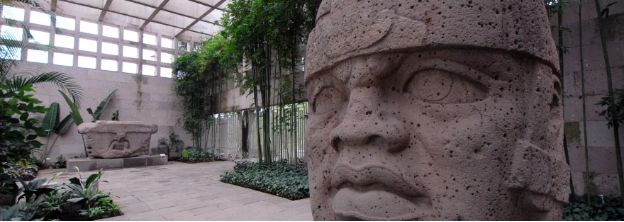
Known as “MAX”, it is a huge museum built in quarry, here you will find elements that give testimony of the three cultures that gave identity to the city; the Olmecs, the Totonacs and the Huastecos.
There is a colossal Olmec head in the place, w hich they say is one of the most beautiful and less damaged, as well as other thousands of pieces of this culture that are part of their collection and that, of course, you can see in full color. It's like traveling through the centuries.
Another part of the museum shows the Totonacs and the cultures of central Veracruz, who are credited with the creation of the Tajin - a ceremonial center that if you don't already know, you should -, as well as other towns like Misantla, Zempoala and Quiahuistlán.
Finally, you'll find the area dedicated to the Huastecos, an indigenous people of Mayan descent who settled in the states of San Luis Potosí, Hidalgo, Puebla and Tamaulipas, in addition to Veracruz. They also have their own language, which they call the Huastecan language, and their influence has led to the creation of a musical style known as “Sones Huastecos”, which you will also hear on your way through the city.
Parque Ecológico Macuiltépetl
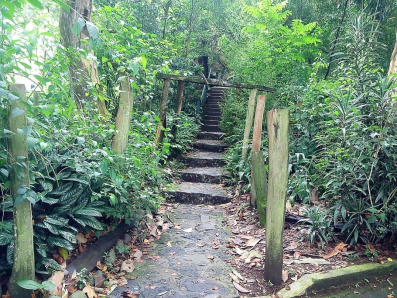
This place is one of the most beloved and significant for the Xalapa people and is part of a volcano that became extinct thousands of years ago and has a fascinating diversity, as it is home to species typical of the Bosque de Niebla (Cloud Forest) such as the seven leaves tree, tree ferns and monsteras such as Swiss cheese plant.
The park is open all year long, has no entrance fee and also has a museum dedicated to the fauna of Veracruz. Another attraction is its observatory, a viewpoint from where you can see through binoculars all the surrounding landscape.
If you are interested in bird watching, there are also guides who will accompany you and instruct you on how to locate them. Some of them are woodpeckers, chachalacas and sparrow hawks. But you will also find other animals like cacomixtles, tlacuaches and squirrels, moving freely among the trees.
Xalapa Cathedral
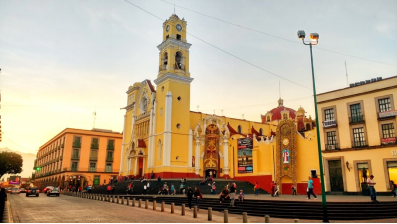
Originally of baroque style, the Cathedral of Xalapa suffered transformations over the years, adopting other styles such as neoclassical, neo-gothic and gothic, which you can find in its interiors and in the chapel where the remains of Bishop Rafael Guizar y Valencia, who was canonized in the early twenty-first century.
In it, there is also a museum where you can see the relics of the now saint, which are attributed to actions such as disguising himself as a salesman to help the dying during the Mexican Revolution and the miracle of curing a child that would be born with malformations detected in clinical studies, something that finally did not happen, because the mother said she had prayed to the bishop.
https://www.visitmexico.com/en/veracruz/xalapa
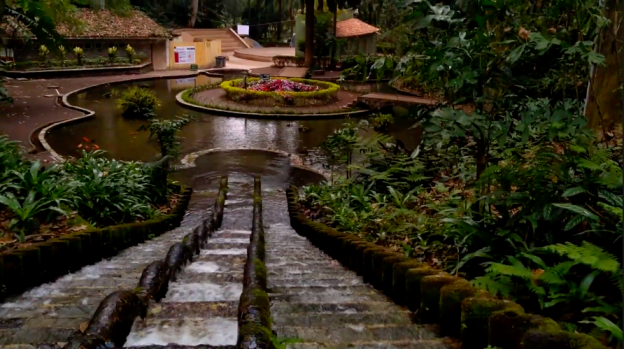
Some of the best places to go out in Xalapa
https://youtu.be/0WzZ_VjLREo
6. History
The Totonacs first established themselves around Macuiltepetl ("fifth mountain" in Nahuatl). This extinct volcano received its name because the Aztecs used it as the fifth reference mountain to get to the gulf of Mexico's shores. Today it is preserved in a park. During the 14th century, four indigenous peoples settled in the territory today known as Xalapa. Each built a small village: Xalitic (in the sand) was founded by the Totonacas; Techacapan (river of waste) was founded by the Chichimecas; in the northeast Tecuanapan (river of the beasts) was founded by the Toltecas, and Tlalnecapan was founded by the Teochichimecas.
Around 1313, the four villages grew together and joined, forming one large village named Xallapan. Moctezuma Ilhuicamina, the fifth Aztec emperor, invaded the territory during the second half of the 15th century. All the land was ruled as part of the Aztec Empire before the arrival and conquest of the Spanish conquistadores.
In 1519 Hernán Cortés passed through en route to Tenochtitlan. In 1555 Spanish Franciscans completed construction of a convent, an important event in the Nueva España of that time.
When the Spanish invaded, Xalapa was barely populated. The population rose after the conquest and colonial settlement. When the Spanish improved the Mexico-Orizaba-Veracruz route, Xalapa declined in importance as a transport hub, and its population stagnated in the 17th century.
From 1720 on Xalapa became increasingly important, due to trade with merchants from New Spain arriving to buy and sell the products of the peninsula. Numerous Spanish families from the nearby towns settled in Xalapa, so by 1760 the population had increased to over 1,000 inhabitants, including mestizo and Spanish. Among local items of commerce were botanical medicines particularly ipomoea purga source of a drug known in English as Jalap. The growth of Xalapa in population, culture, commerce and importance, increased dramatically in the 18th century. Responding to residents' requests, Carlos IV of Spain declared Xalapa a town on 18 December 1791.
In 1772, construction of Xalapa Cathedral began. On 18 May 1784, José María Alfaro got the first air balloon in the Americas, airborne, in Xalapa. Due to the abundance of flowers growing in the region, Alexander von Humboldt, who visited the town on 10 February 1804, christened it the "city of the flowers".
Since the beginning of the 19th century, Xalapa has been the scene of some important historical events. It supported independence from Spain. Ideas flowed freely in the town, and Xalapa was represented by many who put forward these ideas to those in Mexico City government meetings. On 20 May 1821, shortly before Mexican Independence on 27 September the same year, Xalapa was attacked by the forces of Don Antonio López de Santa Anna. Together with Don Joaquin Leño, he forced Spanish captain Juan Horbregoso to surrender the town. Independence was gained months later; the first emperor Agustín de Iturbide was not warmly received in Xalapa due to past differences. On 9 May 1824, by decree of the President of the Republic Don Guadalupe Victoria, the first legislature of the state of Veracruz was established in Xalapa. That year, Xalapa was declared the state capital.
In the 1820s Xalapa and the surrounding area revolted when Vicente Guerrero replaced General Anastasio Bustamante. Veracruz was attacked by Isidro Barradas, who was attempting to reconquer parts of Mexico, and over 3,000 were deployed in the military defense of Veracruz, Córdoba and Orizaba. Anastacio Bustamante, betraying the confidence put him, unsuccessfully revolted against the legitimate government with a new plan of Xalapa, signed on 4 December 1829.
On 29 November 1830 by decree, Xalapa was named a city. In 1843, Don Antonio María de Rivera founded the Normal School of Xalapa to train teachers. Today it operates as a preparatory school for students going to college.
In 1847 in the Mexican–American War Santa Anna attempted to defeat the opposing forces near Xalapa in the Battle of Cerro Gordo. He led an army of more than 12,000 soldiers. Mexican troops suffered many casualties; around a thousand were killed and three thousand wounded on 18 April 1847. The US invaders occupied the city the following day. Among them was Lt. Ulysses S. Grant, later the commanding general of the Union armies in the American Civil War. Grant's letters call Jalapa "decidedly the most beautiful place I ever saw in my life" and its climate "the best in the world."
Xalapeños such as Ambrosio Alcalde and Antonio García fought bravely to defend the city of Veracruz, but were taken prisoner. They were released and paroled, but after rejoining the fighting against the US, they were recaptured near Teocelo, taken to Xalapa, sentenced to death and executed on 24 November 1847. Today these two men are remembered as martyrs. An obelisk commemorates their sacrifice, between San Jose Church and Alcalde Market, named for Ambrosio Alcalde. US forces marched on to capture Mexico City and departed after the Treaty of Guadaloupe Hidalgo.
In November 1862 Xalapa was attacked in the French invasion; foreigners temporarily took control of the state capital. On 27 November 1867 the corpse of emperor Maximilian I of Mexico, who had been executed in Querétaro, arrived and was held in San José, attended by the priest José María y Daza, then transferred to Veracruz the following day. The remains were shipped back to Austria for burial.
In 1885 General Juan de la Luz Enríquez increased the influence of Xalapa when he moved some legislative authority from Orizaba to Xalapa, in accordance with a decree issued in June 1884 by provisional Governor Juan Manuel Fernández de Jáuregui. Enríquez and Swiss teacher Enrique C. Rébsamen in 1886 founded the Normal School in Xalapa, the first school of this type in the country.
Enríquez died in 1892, but the construction of the Normal School and founding of its other schools led to Xalapa becoming known as a center of learning, the "Athens of Veracruz".
Under Enríquez, the old San Francisco convent was demolished, and the area developed into Parque Juárez. In June 1890 railroad construction brought the first locomotive on the Xalapa--Coatepec-Teocelo railroad to the city. The interoceanic railroad was completed in Veracruz in 1901. The public lighting system was introduced in 1904. In 1906 a clock was installed in the centre of the city on a building on Enríquez Street, which now houses the National Lottery agency.
On 18 May 1911, Francisco I. Madero visited Xalapa. On 21 June of the same year a minor conflict occurred between federal forces and revolutionaries.
On 3 January 1920, a strong earthquake rattled the city, destroying several buildings. Years later in December 1923, Xalapa fell into the power of the huertístas, commanded by Guadalupe Sánchez.
In 1940 the water building and agricultural house were constructed, today is occupied by the Agrarian League of Communities and Union Farmers of the State. On 11 September 1944 the Universidad Veracruzana was established, and Dr. Manuel Suárez became its first director. On 4 September 1978, by decree number 325, the Local Legislature declared that the official name of Xalapa Enríquez should be written with a "X" rather than a "J", to emphasize its derivation from Nahuatl.
7. Other Information: Cultural and Student City
Xalapa is known as the "Athens of Veracruz" because of the strong cultural influence of its major university, Universidad Veracruzana (the main public university in the State of Veracruz). General Enriquez is known for policies encouraging the educational system in Xalapa.
Xalapa is a college town that enjoys some fine colonial architecture as well as a nice climate in the highlands above the hot and humid Veracruz coast. It is a hilly town with a smart population hence it is sometimes considered to be the San Francisco of Mexico. Home to a considerable number of expatriates and foreign exchange students, the town really isn't on the typical backpacker/tourist path through Mexico.
Culturally, Xalapa has a wide variety of events associated with its theatres, museums, and street art. Many musicians and dancers frequently perform in the center in the nights, especially on special occasions and events of celebration or commemoration; they often dance the fandango.
Art has a keen following in Xalapa. The gallery, Pinacoteca Diego Rivera, located near the City Hall and Parque Juárez in downtown, has the most numerous collection of Diego Rivera's paintings in all of Mexico.
https://wikitravel.org/en/Xalapa
8.Contact Information

City Mayor: Pedro Hipólito Rodríguez Herrero
Contact number: +52 (228) 842 1200, ext. 5009, 5056
Govt. Office Address: Palacio Municipal, calle Enriquez s/n, Col. Centro
FB: https://www.facebook.com/hipolitordgz
Twitter: https://twitter.com/hipolito_rguez
Website: https://ayuntamiento.xalapa.gob.mx
E-mail: presidencia@xalapa.gob.mx
